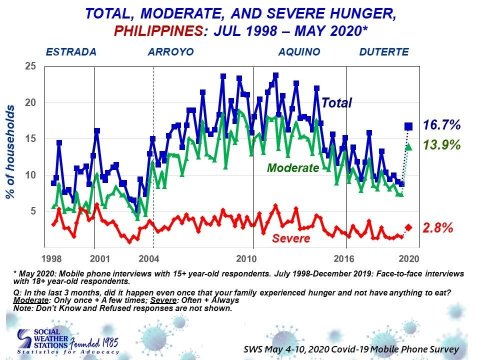Social Weather Stations (SWS) found that 16.7% or 4.2 million Filipino families have been starving for food in the past three months due to the COVID-19 crisis.
The number is nearly doubled from December 2019, which is 8.8% or 2.1 million families).

SWS surveyed 40,010 Filipinos aged 15 and above nationwide using mobile phones and computer-assisted telephone interviews. It started on May 4 and ended on May 10.
The survey also found that 99% of families have been receiving food aid since the coronavirus disease (COVID-19) crisis began, mostly from the government.
The rate of 16.7% came after combining the different levels of hunger experienced by Filipinos: moderate hunger (13.9%); severe hunger (2.7%).
“Moderate hunger” refers to those who have experienced hunger “once” or “just a few times” in the last three months.
That is higher than 7.3% (1.8 million families) in December 2019. That is also the most elevated moderate hunger since 14.1% recorded in September 2015.
“Severe hunger” refers to the “frequent” or “always” hungry in the last three months.
The severe hunger rate soared from 1.5% (357,000 families) in December 2019. That is the most significant increase in severe hunger since 2.8% (643,000 families) recorded in September 2008.
Also read: Survey says 80% of Pinoys satistified with government’s COVID-19 response
Number of starving Filipino families increased nationwide
Those suffering from severe hunger came from all over the Philippines:
- Metro Manila (20%) — 693,000 families
- Balance Luzon (12.6%) — 1.4 million families
- Visayas (14.6%) — 685,000 families
- Mindanao (24.2%) — 1.4 million families
Metro Manila had just 9.3% in December 2019. The current hunger rate is the highest in the region since it reached 22% in September 2014.
In Balance Luzon, it was only 6.3% in December 2019. It is also the highest famine rate in the area since it recorded 12.7% in September 2018.
The same goes for the Visayas. It was only 9.3% in December 2019, but it is now the highest hunger rate in the area since it rose to 16.7% in December 2016.
The current data for Mindanao is also higher compared with 10.3% in December 2019. It is now the highest percentage of famine in the archipelago since it reached 29.2% in March 2013.
SWS explained the questions related to the hunger experienced by a family, their experience in receiving aid during the COVID-19 crisis, and their source of food aid was not commissioned.
The SWS also said they conducted the survey on their initiative, and the results were released to serve the public.
